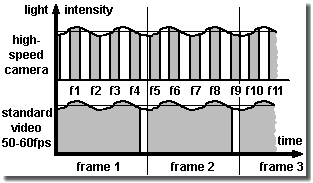
WP's HP: HOME
| SloMo: Links
~ FAQ ~ Info ~ Tips ~
Data ~ Clips
~ HYCAM ~ [Freq.] ~
f-Calculator ~ Trigger ~ Image
RAM | ?Help? | Deutsch

Effective or nominal mains voltage of 115 V or
230 V alternates 50 or 60 times per second between the square
root 2 higher peaks ±163 V and ±325 V, resp.
Illumination devices directly driven by AC mains are pumping more
or less with this mains frequency of 50 Hertz or 60 Hertz, resp.
(1 Hz (Hertz) = 1/sec). Usually a light bulb is too sluggish
to show these changes. And of course, our eyes are too slow to
perceive these variations. Also a video camera usually does not
take notice of these flickers.
Even so-called DC lamps, where electronics rectify or smoothen the
ac voltage, can show a certain ripple or oscillation of higher
frequencies a movie or a video camera does not note, but a
high-speed camera of sufficient frame rate does.

Sequence and flickering illumination
That's the cause for a frequent fault report:
»The camera sequence flickers and jitters!«.
This is, however, not a fault of the high-speed camera. The reason
is connected with the so-called Nyquist-Shannon-Kotelnikov theorem
of sampling, refer to the figure on the left. If one measures a
changing quantity with at least double of its frequency, one will
be able to reconstruct its curve shape.
In the figure on the left the video camera runs almost with half
the frequency of the ripple of the illumination source, whereas the
high-speed camera is factor four to five faster again. The gray
areas give the amount of light per frame. The white areas show the
read-out time or inactive phases.
It is clearly to see how ups and downs of the intensity compensate
themselves more or less, the video camera is integrating over them.
Usually this is independent of the phase shift.
The frames of the high-speed camera, however, are exposed with
varying values. The sequence will flicker, when replayed in slow
motion. Something one can often notice in slow motion sequences of
sports event broadcast on TV.
Only if one (strictly) reduces the time of exposure of the video
camera, narrower gray and wider white areas in the figure above,
one will be able to make it flicker as well. With clever
synchronized frequencies, however, it may not necessarily
happen.
Using a frame rate of some 100 frames/sec one is able to shoot the
pumping of fluorescent tubes. Therefore this kind of illumination
is not very suitable for high-speed cameras.
Merely lamps driven by a battery (DC voltage) are safe from
high-speed cameras. But usually halogen lamps with 50 or 60 Hz
due to their inertness are sufficient for usage in technological
set-ups.
Effect well-known - the coach moves forward, its wheels
turn backward - is a consequence of the sampling theorem as well.
Between two succeeding movie images the wheel rotates by slightly
less than one full turn. Or by some full turns whereas the last
turn is not completely finished. That is a special case of the
stroboscope effect where one tries to capture a still image of a
rotating object by shooting integer multiples of a single turn.
One's brain interprets these images then in the wrong way as pseud
movement or just as no movement.
You can perceive the same effect with rotating propellers or
helicopter rotors.
Except for technical defects, there are two causes. At
first the replay rate can be so low that a fluent sequence is not
given. One must offer ones eyes 14 frames/sec at least in order to
prevent them from visualizing the single frames and to keep up the
illusion.
On the other hand a very short shutter time (time of exposure; in
each frame x shown in the figure above just one single small gray
column) compared with frame rate or movement, resp. can cause the
movement appearing choppy because too much location change happens
from frame to frame.
©WP (1998 -) 2012
http://www.fen-net.de/walter.preiss/e/slomo_sc.htm
Update: V8.4, 2012-03-02